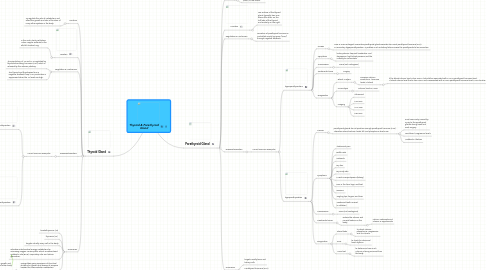
1. Thyroid Gland
1.1. Function
1.1.1. To regulate the rate of metabolism and affect the growth and rate of function of many other systems in the body.
1.2. Location
1.2.1. In the neck: starts just below Adam's apple, extends to the 5th/6th tracheal ring.
1.3. Regulation & Mechanism
1.3.1. The production of T3 and T4 is regulated by thyroid-stimulating hormone (TSH), which is released by the anterior pituitary.
1.3.2. The thyroid and thyrotropes form a negative feedback loop: TSH production is suppressed when the T4 levels are high.
1.4. Diseases/Disorders
1.4.1. 2 most common examples
1.4.1.1. Hypothyroidism
1.4.1.1.1. Causes
1.4.1.1.2. Symptoms
1.4.1.1.3. Treatments/Cures
1.4.1.1.4. Transmission
1.4.1.1.5. Diagnostics
1.4.1.2. Hyperthyroidism
1.4.1.2.1. Causes
1.4.1.2.2. Symptoms
1.4.1.2.3. Treatments/Cures
1.4.1.2.4. Transmission
1.4.1.2.5. Diagnostics
1.5. Hormones
1.5.1. triiodothyronine (T3)
1.5.2. thyroxine (T4)
1.5.3. targets virtually every cell in the body
1.5.4. activates mitochondrial energy metabolism by increasing oxygen consumption, which increases basal metabolic rate (BMR), respiratory rate, and calorie generation.
1.5.5. upregulates gene expression of structural proteins for growth and dozens of enzymes needed for intermediator metabolism.
1.5.5.1. metabolism, growth and functioning of other body systems
2. Parathyroid Gland
2.1. Function
2.1.1. to increase the concentration of calcium (Ca2+) in the blood.
2.2. Location
2.2.1. rear surface of the thyroid gland: typically two, one above the other, on the left lobe of the thyroid and similarly on the right.
2.3. Regulation & Mechanism
2.3.1. Secretion of parathyroid hormone is controlled mainly by serum [Ca2+] through negative feedback.
2.4. Diseases/Disorders
2.4.1. 2 most common examples
2.4.1.1. hyperparathyroidism
2.4.1.1.1. Causes
2.4.1.1.2. Symptoms
2.4.1.1.3. Transmission
2.4.1.1.4. Treatments/Cures
2.4.1.1.5. Diagnostics
2.4.1.2. hypoparathyroidism
2.4.1.2.1. Causes
2.4.1.2.2. Symptoms
2.4.1.2.3. Transmission
2.4.1.2.4. Treatments/Cures
2.4.1.2.5. Diagnostics
2.5. Hormones
2.5.1. targets mostly bone and kidney cells
2.5.2. Parathyroid hormone (PTH)
2.5.3. Parathormone or parathyrin
